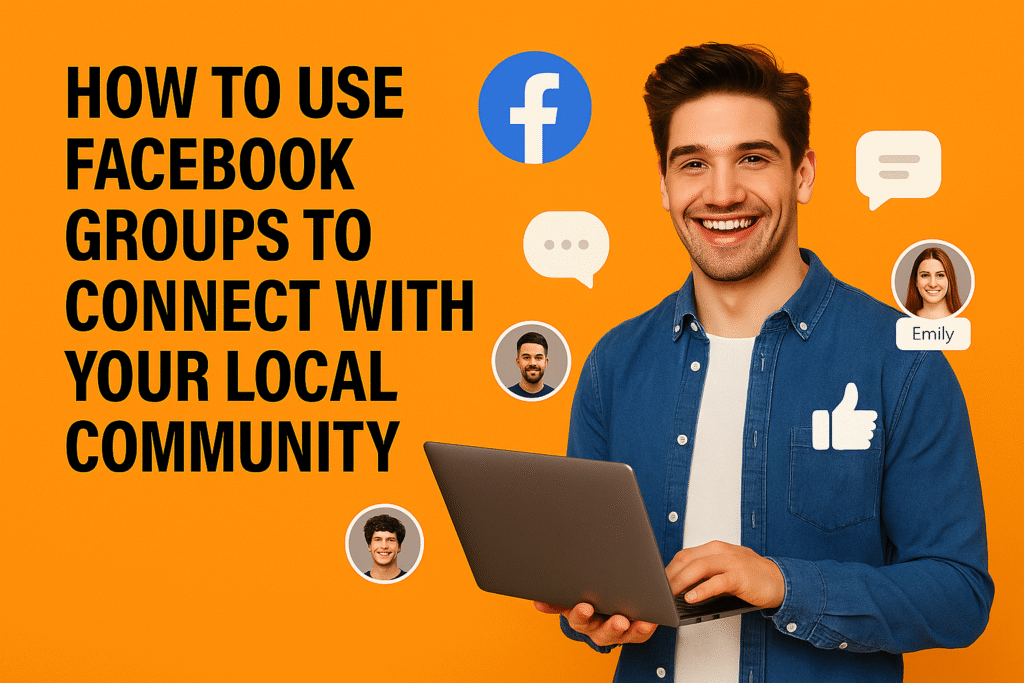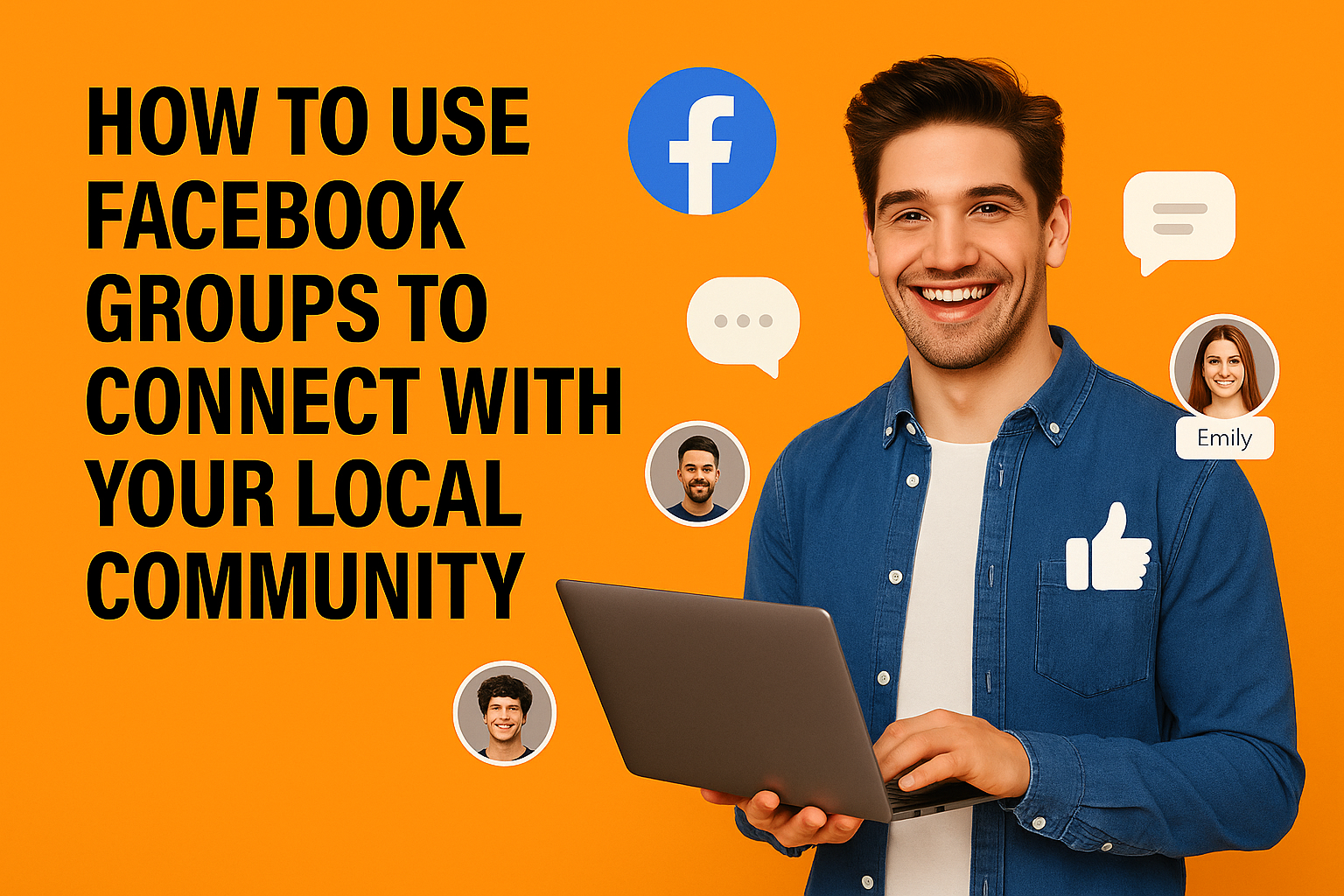How to Use Facebook Groups to Connect with Your Local Community


In today’s digital world, building a strong local community is more important than ever for UK businesses.
Whether you’re running a neighbourhood café in Manchester, a boutique in Brighton, or a service business in Birmingham, your success is rooted in the relationships you build with people nearby.
But how do you nurture those connections in a fast-paced, online world? The answer for many businesses is Facebook Groups.
Facebook Groups have become one of the most effective—and affordable—ways to bring local people together, create a sense of belonging, and foster real loyalty.
At Socially Spotted, we’ve seen how a well-managed Facebook Group can transform casual customers into loyal fans, spark word-of-mouth buzz, and make your business a true local favourite.
If you’re ready to harness the power of Facebook Groups to connect with your local community, this guide will show you exactly how to get started, grow your group, and keep it thriving.
Why Facebook Groups Are a Game-Changer for Local Community Building
Unlike business pages, which are mostly about broadcasting updates, Facebook Groups are all about conversation and community.
They act as virtual gathering spaces where people with shared interests, needs, or locations can come together.
For local businesses, this means:
- Direct engagement with your neighbours and loyal customers
- A platform for sharing updates, offers, and local news
- A space for customers to ask questions, give feedback, and share experiences
- Opportunities for collaboration, networking, and mutual support
Groups help you build trust, foster loyalty, and keep your brand top-of-mind in your neighbourhood—all without spending a penny on ads.
Step 1: Set Clear Goals for Your Facebook Group
Before you create your group, get clear on what you want to achieve. Do you want to:
- Support other local businesses and create a network?
- Build a space for customers to ask questions and share feedback?
- Promote local events, news, and offers?
- Create a hub for sharing tips, recommendations, or resources?
Your goals will shape everything from your group’s name to the content you post.
Example:
A bakery in Leeds creates a group called “Leeds Foodies & Local Eats” to share recipes, promote local food events, and connect with other independent food businesses.
Step 2: Set Up Your Facebook Group
- Log in and Create Your Group:
From your Facebook homepage, click “Groups” on the left, then “Create new group.” You can also use the “+” or “Create” menu at the top. - Name and Describe Your Group:
Choose a name that’s clear and relevant to your area or business (e.g., “Brighton Small Business Network” or “Manchester Mums Community”). Write a short description explaining the group’s purpose—connecting locals, sharing recommendations, supporting businesses, etc. - Choose Privacy Settings:
Decide if your group will be Public (anyone can see posts and join) or Private (only members can see content). For most local groups, Private and Visible is best—it encourages open sharing but keeps conversations within the community. - Customise Your Group:
Upload a welcoming cover photo, set your location, and fill out any additional details. Add a few founding members (staff, loyal customers, or local partners) to get things started.
Step 3: Establish Clear Group Rules
A successful Facebook Group is built on respect and clarity. Set group rules to ensure a positive, productive environment.
Common rules include:
- No spamming or irrelevant links
- Respectful, supportive communication
- No hate speech or bullying
- Keep discussions local and on-topic
- Respect member privacy
Facebook allows up to 10 public rules—make them visible and enforce them consistently.
This helps prevent spam and keeps your group welcoming and focused.
Step 4: Invite and Welcome Members
Start by inviting your existing customers, local partners, and friends.
Share the group link on your business page, website, and in your shop or emails.
Encourage members to invite others who might benefit from joining.
Onboarding tip:
Set up an automated welcome message or post to greet new members, introduce them to the group’s purpose, and highlight the rules.
Tag admins so new members know who to contact with questions.
Step 5: Foster Engagement and Daily Discussion
A group thrives on active participation. Here’s how to keep your community buzzing:
- Post regular updates: Local news, business tips, event announcements, or industry insights
- Ask questions and run polls to spark conversation (“What’s your favourite local takeaway?”)
- Share behind-the-scenes moments or customer stories
- Feature a “Business Spotlight” to showcase local enterprises
- Encourage members to share their own news, recommendations, or questions
Interactive features like polls, live broadcasts, and community chats make your group more dynamic and fun.
Step 6: Use Facebook’s Built-In Features
Facebook Groups offer several tools to boost engagement:
- Polls: Gather opinions, run quizzes, or let members vote on group decisions
- Live Broadcasts: Host Q&As, virtual meetups, or workshops to connect in real time
- Events: Promote local happenings or online events
- Files and Guides: Share resources, how-to guides, or community documents
These features help you create a vibrant, interactive space that keeps members coming back.
Step 7: Spotlight Local Businesses and Events
Support your local community by regularly highlighting other businesses, charities, or events.
Consider a weekly “Local Business Spotlight” or “What’s On This Weekend?” post.
This not only provides value to your members but also encourages cross-promotion and collaboration.
Example:
A group for independent shops in Bristol features a different store each week, sharing their story and special offers. Members love discovering new places to support, and businesses gain new customers.
Step 8: Encourage Collaboration and Networking
Use your group as a platform for collaboration. Organise virtual meetups, networking sessions, or collaborative projects.
Encourage members to share advice, resources, or even job opportunities.
The more value your group provides, the more engaged and loyal your community will be.
Example:
A tradespeople group in London organises monthly online Q&A sessions where members answer each other’s questions and recommend trusted local partners.
Step 9: Keep the Group Active and Positive
A thriving group needs regular attention:
- Post consistently—aim for at least a few updates per week
- Respond to comments and questions promptly
- Moderate discussions to keep things respectful and on-topic
- Celebrate milestones, birthdays, or group achievements
A positive, well-managed group becomes a trusted resource for your local community.
Step 10: Measure Success and Adjust Your Strategy
Use Facebook’s built-in analytics to track group growth, engagement, and popular topics.
Pay attention to which posts spark the most conversation and what your members value most.
Use these insights to refine your content and keep your group relevant and lively.
Real-World UK Examples
- Little Moo’s Boutique created a Facebook Group for customers to share purchases, recommendations, and feedback. The group grew from a few hundred to over a thousand members in months, boosting loyalty and sales.
- Cupcake Joy Bakery used their group to run contests, announce flash sales, and gather feedback, doubling their sales and reach through member engagement and word of mouth.
- Local community groups in cities like London and Edinburgh use Facebook Groups to organise events, share safety updates, and support local causes, strengthening neighbourhood bonds and business connections.
FAQs:
How do I start a Facebook Group for my local business?
Log in to Facebook, go to “Groups,” and click “Create new group.”
Name your group, add a description, set privacy settings, and invite your local audience.
What should I post in my local Facebook Group?
Share local news, business tips, event updates, polls, customer stories, and spotlights on other local businesses.
Encourage members to share their own experiences and questions.
How can I keep my Facebook Group active?
Post regularly, use interactive features like polls and live videos, welcome new members, and encourage discussions.
Spotlight local businesses and celebrate group milestones.
Should my Facebook Group be public or private?
For most local groups, “Private and Visible” is best—it encourages open sharing while keeping conversations within the community.
How do I handle spam or negative behaviour in my group?
Set clear rules, moderate posts and comments, and address issues promptly.
Remove spam and warn or remove members who break the rules.
Conclusion
Facebook Groups are one of the most effective ways for UK businesses to connect with their local community, build trust, and create lasting relationships.
By setting clear rules, fostering daily engagement, spotlighting local businesses, and using Facebook’s interactive features, you can turn your group into a vibrant hub that benefits everyone involved.
At Socially Spotted, we help businesses harness the power of social media to grow their local presence—so start your group today and watch your community thrive!
